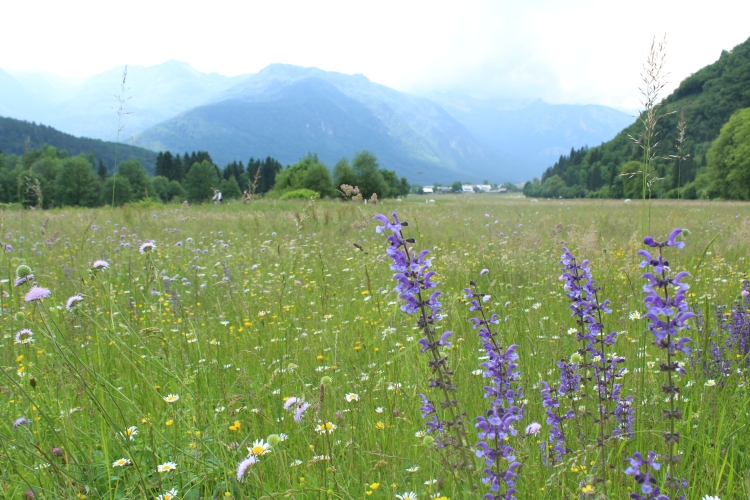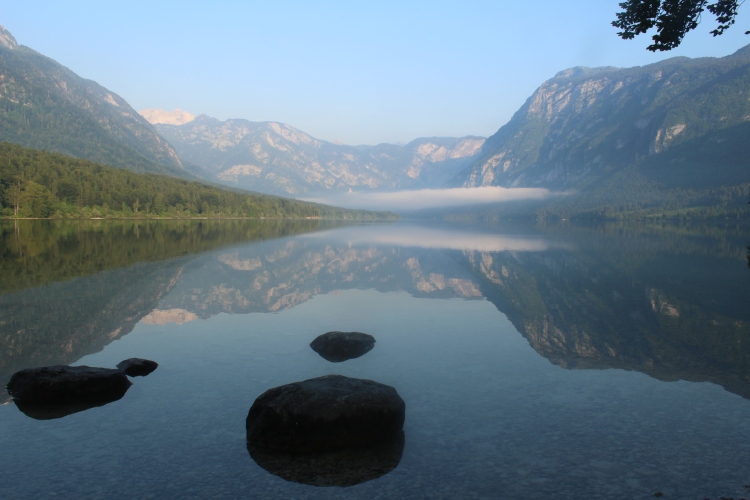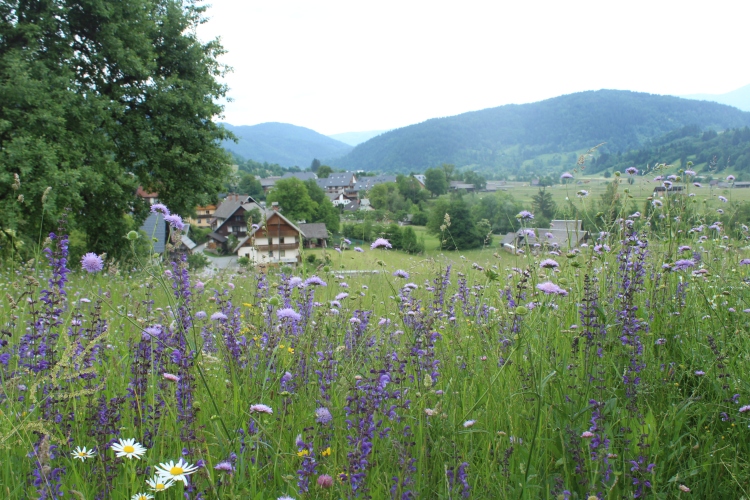This year I’ve been fortunate enough to travel abroad in search of plants, knowledge and inspiration by studying meadows and wild flowers in Slovenia, the Outer Hebrides (St. Uist) and Northern England. Travelling has always been a passion for me and is one of the reasons that I served in the military prior to my horticultural journey. So to be able to visit different countries in search of plants filled me with huge excitement and gave me a smile that I carried around the garden for weeks before I set off.
My particular interest in meadows stems from my own job at Sissinghurst where I manage the meadows as well as teach scything and traditional hay and meadow management. The purpose of my trip mainly was to discover how meadows were perceived and valued in Slovenian and Scottish cultures, compared to our own and the measures they are taking to protect them.
But before I begin, I must first give huge thanks to the Great Dixter charitable trust for allowing me to go on this fantastic trip by awarding me the Christopher Lloyd bursary.
I set off to Slovenia brimming with excitement in late May. From such an extensive trip it’s nearly impossible for me to even skim the surface of what I learnt and I wouldn’t do the trip justice in so few words, so for now I’ll share with you some of my highlights from Slovenia.

Slovenian Meadows
When I landed in Ljubljana, much to my delight, my first sight of this beautiful country were farmers scything and processing hay on the air field itself. I then travelled to the valley of Bohinji which is celebrated for its meadows and spent the next 9 days searching for different meadows and wild flowers.

Lake Bohinji
I climbed mountains up to 1900m and saw the great alpine pastures full of flowers such as Gentiana clusii, Globularia cordifolia, Veratrum album and Lilium carniolicum. In the lowland areas I witnessed the traditional hay meadows which were full of Capanulas, Knautias, Salvias, orchids of all types and so much more, making me green with envy. I saw Astrantia major meadows and even an Echium vulgare meadow and I cannot even begin to explain its beauty.
While searching for plants I met local botanists who led me over hills and valleys hunting out over 15 species of orchid while also explaining Slovenia’s changing landscape over the years. I saw hundreds of plant and colour combinations, such as bearded irises Iris cengialti vochinensis growing wild with Sweet Williams Dianthus barbatus amongst Lilium carniolicum and I quickly filled an entire note book with different combinations that I could use back at home. I also loved noting how plants had colonised themselves and particularly the patterns created by them seeding, a method which Vita was fond of and one I also love.
I found the locals to be warm and welcoming and was invited to a village party where we scythed and racked hay in the hot afternoon sun, followed by singing and dancing in the evening. They fed me some very peculiar food accompanied with the strongest homebrew that could almost take your eyebrows off!
I managed to undertake an interview with a school and discovered how they’re teaching future generations about the importance of wild flowers. All the information I found taught me so much and allowed me to visualise the future of Slovenia’s meadows. I saw areas that had been destroyed and others which had been saved, and although they know the value of their meadows and are teaching their youngest generations, the future of their wild flowers balances on a knife edge.

Village meadows
Will increasing demand and population cause the decline in wild flowers the way it has in so many western countries or will tradition and heritage prevail and the meadows be saved? Everyone I spoke to had conflicting views, but only time will truly tell.
Josh












I’m very jealous, Josh. Slovenia looks gorgeous. A friend of mine went some years ago on a walking holiday and on her recommendation (and now your photos) I’m planning a cycle trip there next year. I wasn’t sure when to go but May seems to be the answer. Dave
LikeLike
It was amazing David and I would definitely recommend going. The time to go depends on what you want to see. Meadows are at the best during the second half of May and are generally cut down at the end of the second week in June (weather dependent). The alpine flora puts on a good show during the end of June into July, which is a tad annoying because to see both you really need two trips. There is a wildflower festival from May into June which is a good event to visit and gives you loads of information.
http://www.bohinj.si/alpskocvetje/eng/
LikeLiked by 1 person
Thanks for sharing…What a lovely area, and, as you note, full of inspiration for planting combinations. With pollinators, birds, and other wildlife so under threat let’s hope we see the knife-edge tip towards heritage, tradition and healthy meadows. Haven’t been to Sissinghurst yet, (possibly last gardener on earth to not have : /, but look forward to seeing resonances of your recent travels, when I do…
LikeLike
I did literally fill entire notebooks with combinations and the patterns in which plants had colonized themselves. In fact today I’m planting all the Alliums in the Rose garden and have used my notes and photos from Slovenia to help me lay them out. The fact that the local agency’s and people recognise the importance of the wildflowers and grasslands will keeps them secure through a somewhat national pride. I mean local councils here back in UK, managing the road verges and grass areas as wildflower areas is relatively new and still seen as a negative by people.
Hope you can come next year, if you come in July I’m sure you’ll see me and could jump on one of my meadow walks.
Josh
LikeLiked by 1 person
Thanks Josh..looking forward to seeing how the plantings progress : )
LikeLike
Thanks Josh, your photos alone are a great argument why meadows are not only so important to the whole ecology but so beautiful to look at! I’ll have a closer look at the meadows on my next visit to Sissinghurst – I’m sure you’re doing a fine job!
LikeLike
Thank you George, and please do have a closer look. Hopefully all the green hay from Marden will germinate nicely and give us a great display next year. Finger crossed for Green Winged Orchids.
Josh
LikeLike
Lovely post – and aren’t you lucky to be able to encounter and learn from all that. But you know … all of Europe is very rural, and there are more meadows managed in a traditional way here than seems possible. Even in quite built up parts of Italy, there are older people still doing what they have always done. The truth is that the European flora is just richer than the British. And such a large landmass. Not all is cultivated, much managed (by default) in an style. Come and see the flowers of Lorraine, Haute Marne and Haute Saone next year … Re David’s comment above. I did an AGS/SRGC sponsored trip to the Karawanken mountains in Austria many years ago. July is a very good time also for almost alpine European meadows.
LikeLike
Wanted to edit my comment above (sent too soon …). Here goes: ‘… in a style’. Read ‘in a more traditional style’ … Also – July is a great month for European flora (where meadows have not been cut in June) …hope this helps in your future explorations. And ‘bonne chance’ …
LikeLike
Thank you Cathy, your observations are very useful and you’ve given me some areas to put in my travel notebook for the next few years.
Josh
LikeLiked by 1 person
Lovely pictures,I don’t know much about the country, is it just the hilly,mountainous areas that have such wonderful flower meadows?
LikeLike
Hello Brian
Its the lowland areas that have the richest floral perennial meadows. However as you climb to around 900m you begin to find different species due to a much freer draining soil, sunnier aspect and alpine tendency’s. If you climb to around 1600-2000m you’ll find the true alpine pastures and alpine plants. The lowland meadows to me had a beauty in the mass, 10 notable species, repeated over miles and miles. One of the characters that makes me love meadows so much. The alpine flora became like rare jewels to be found, one rare species growing from a rock that sparks fascination and interest that all gardeners have. In fact the path to Vogel became more like a botanical garden, with species after species being laid out for me.
Hope that helps
Josh
LikeLiked by 1 person
Wow, amazing place with so many beaymeadows and wildflowers.
LikeLiked by 1 person
Pingback: Josh Sparkes: February 8 – Beckley Haughty and Cultural